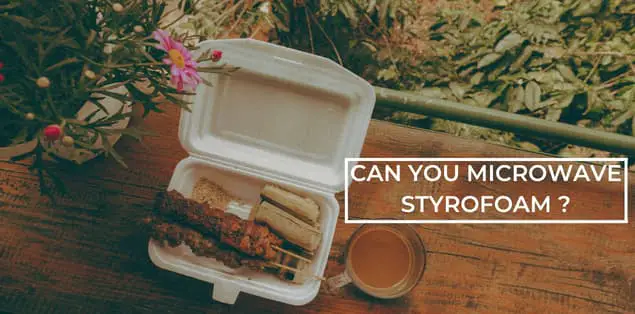So, can you microwave styrofoam? Styrofoam comes in various shapes, sizes, and compositions, as do the containers in which manufacturers package it. For example, adding Styrofoam to other materials and reheating meals in Styrofoam are possible uses.
We’ll not give a yes-or-no response to whether or not you can microwave Styrofoam. Instead, we’ll break it down by the kind of Styrofoam to assist you in answering all of your inquiries.
Styrofoam is a common household item, and we’ll explain why you should or shouldn’t microwave it in each category.
We hope this answers some of your questions about microwaves and Styrofoam.
So, without any further ado, let’s jump right into it!
Can You Put Styrofoam in the Microwave?
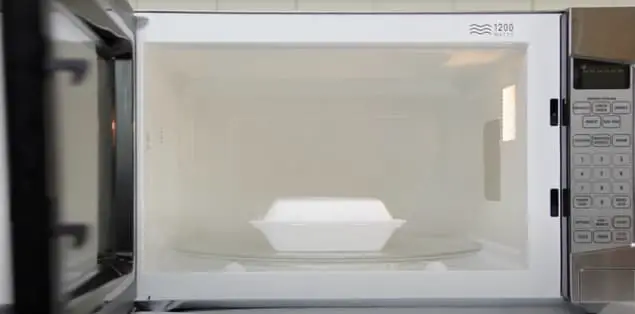
No.
Styrofoam containers manufacturers make to consume with food made from expanded Polystyrene are not suitable for use in the oven. At a temperature of 212 degrees Fahrenheit, these Styrofoam containers will become brittle and completely melt at 464 degrees. On the other hand, you may use them to store food in the refrigerator; nevertheless, you should never try to cook with them or reheat them in the oven.
The Food and Drug Administration (FDA) does regulate plastic and polystyrene containers, cups, and plates. In addition, it conducts safety tests on their use in microwave ovens. These tests ensure that the number of chemicals leaching out is between one hundred and one thousand times lower than the amount harmful to lab animals.
You can take any container capable of achieving this goal with a microwave-safe symbol. The symbol indicates that the takeout containers have been tested and found safe for use in a microwave. Therefore, before placing any styrofoam containers into the microwave, check the labels to ensure they are microwave-safe.
Some other things to keep in mind while reheating in the microwave:
- Put the meal in a microwave-safe container made of glass or ceramic if you cannot inspect whether the Styrofoam container it came in can withstand the heat of the microwave.
- Use wax paper, parchment, or even paper towels to cover meals while reheating them in the microwave if you desire to do so. To prevent the plastic wrap from melting inside the microwave while you’re heating it, food shouldn’t come into contact with it.
- Remember that it may be tempting to use those plastic tubs to keep yogurt, cream cheese, mayonnaise, and other items as extra food storage in the refrigerator. However, such containers are not safe to use in the microwave.
- Note that plastic containers you’ve cracked, damaged or microwaved an excessive number of times run the risk of leaking hazardous plastic particles into the food they hold.
- Do not use food containers for which you have any concerns about their suitability for use in the microwave. You may take advantage of microwave cooking food’s many benefits. If you pay attention and read the labels properly, you’ll ensure the well-being of you and your loved ones.
Can You Microwave Styrofoam Cups?
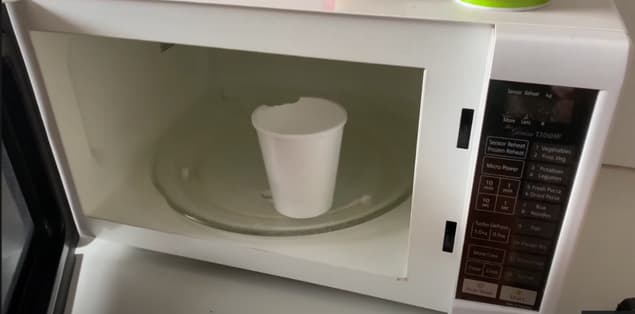
The answer is NO.
The fact that conventional Styrofoam is a kind of plastic is why the answer has traditionally always been no. It is created to be porous and incorporates a variety of compounds throughout.
The issue when you try to heat Styrofoam in a microwave is that it will rapidly melt, even after only a few seconds of exposure to the heat. This accomplishes two separate goals. First, to begin with, it compromises the overall quality of the Styrofoam cup. Second, once the Styrofoam within the cup starts to melt, it has the potential to release a wide variety of chemicals into whatever is currently present inside the cup.
Small amounts of these chemicals may not make you sick. However, exposure to them over a long period can be dangerous and lead to severe illnesses.
Thankfully, newer varieties of Styrofoam that you can heat in the microwave have become available. A good rule of thumb is to inspect the cup for a logo indicating that you may heat it in a microwave. In most cases, it will appear like a very small microwave emitting very few waves.
If your cup contains this, you may safely heat it in the microwave. If this is not the case, you should consider heating food or your beverage using another method instead of the microwave since it is safer.
Can You Microwave Styrofoam Plates?
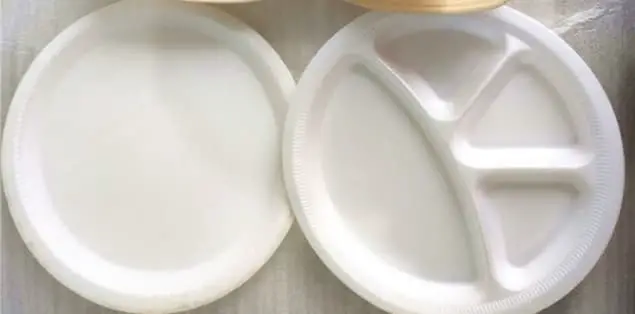
No.
As a result, Styrofoam plates, like their cousins, the cylindrical cups, have many of the same issues. So if you are using standard Styrofoam plates, you should stay far away from the microwave as if it were on fire.
But, if you still have the packaging for your plates and are aware that you can safely heat them in the microwave, then you should, by all means, proceed with heating them in the microwave.
Even with safety precautions, using a microwave may still be dangerous. Like what we discussed concerning the cup, most Styrofoam has a low melting point. Although the melting point of regular Styrofoam is 240 degrees Celsius, the material will begin to droop, bend, and warp at temperatures as low as 80-100 degrees Celsius.
Even if the cups or plates you use are safe for the microwave, we strongly advise you to exercise extreme caution and only microwave them for brief periods. This is because they will still emerge from the microwave at an extremely high temperature, and prolonged microwaving may still cause them to melt.
When using a microwave, it is imperative that you exercise caution and safety at all times.
Can You Microwave Styrofoam for 30 Seconds?
No.
In the food and beverage sectors, Styrofoam is a widely recognized disposable container that people regularly use for taking out and receiving delivery of products. Because it is one of the simplest kitchen appliances and is simple to prepare food in, the microwave is often used for heating and reheating food items.
You are aware that the materials are incompatible with the microwave. However, in thirty seconds, its optimal degree of safety is determined by several elements, including the amount of energy present and the specifications of the design.
You don’t want any styrene or other compounds in your diet, particularly savory things like cheese and meat. However, you especially don’t want to consume other chemicals.
You can only strain styrene at temperatures between 392 and 435 degrees Fahrenheit. However, the highest temperature you can reach in a microwave is typically 212 degrees.
Even though 30 seconds is not a very long time to reheat food, we advise you not to microwave a container made of Styrofoam. However, you can do so if the manufacturers have labeled it safe for microwaving.
However, this does not imply that you should dispose of your leftovers in the trash. However, when reheating cold meals, you may always utilize safer materials.
Reheating your food is as easy as moving the food from the Styrofoam container into a baking tray coated with aluminum foil and placing it in the oven. This will provide the hot dishes with an appetizing crispness that will make them taste fresher.
You may also choose to reheat your food on the stovetop, in the microwave using paper plates or a microwave-safe dish, or even on the stovetop itself.
Is It Safe to Heat Food in Styrofoam?
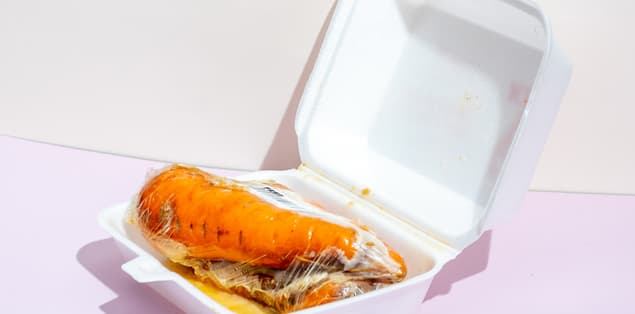
Not really.
Since manufacturers don’t make certain containers to be heated in the microwave, attempting to heat Styrofoam in the microwave might have devastating results.
You are already aware that the component of Styrofoam known as styrene will be released when the temperature reaches a certain level.
You are now aware that extended exposure to styrene might cause cancer. However, it is not apparent how much exposure would be necessary. Additionally, you are aware that the exact amount of exposure that would be required is not known.
In addition to all of that, there is yet another concern.
When you microwave food in Styrofoam containers, there is a possibility that some of the chemicals and other components of the Styrofoam might leak into the food.
Styrene is not the only chemical involved in microwaving process; there are other additional compounds.
When you reheat dishes that are high in fat, there is a larger possibility that contaminants may seep into your food. This indicates that meats and cheeses are at the top of the priority list.
Does Microwaving Styrofoam Release Toxins?
The response is going to be yes!
The fact that Polystyrene is in its name indicates the presence of compound styrene. Styrene is not nearly as risk-free as its reputation would lead one to believe, even though it is a component in manufacturing synthetic rubber and latex.
According to research carried out in 2009 by B. L. Momani at the Worcester Polytechnic Institute, “Polystyrene has been proven to leak styrene into water and food. Styrene has been linked to an increased risk of cancer and has shown properties to alter hormones.
Since endocrine disruptors are known to produce issues in the reproductive systems of animals, it is reasonable to assume that they also impact humans’ health.
Along the same lines, you have most likely been familiar with the chemical known as bisphenol-A. This is another endocrine disruptor you can find in plastic goods that companies use to coat the insides of certain containers, such as water bottles and canned foods.
Final Words
Whether it’s safe to microwave Styrofoam depends on if the container has the microwave-safe label. If it doesn’t, please don’t risk it anyway. Polystyrene contains a compound known as styrene, that’s a potential carcinogen. Styrene can leach into your food, making it all the more dangerous.
You should not microwave polystyrene containers without a microwave-safe label since no one cannot guarantee their safety.
The chemical styrene found in polystyrene containers has been related to cancer in studies.
If you’re concerned about styrene in your food, you should avoid containers marked as microwave safe.
You should use microwave-safe containers like ceramic, glass, or pyrex if you have any doubts about the safety of your food.
Be sure to pass on this information to your family and friends, especially those who eat a lot of takeouts! It could just save their lives.
